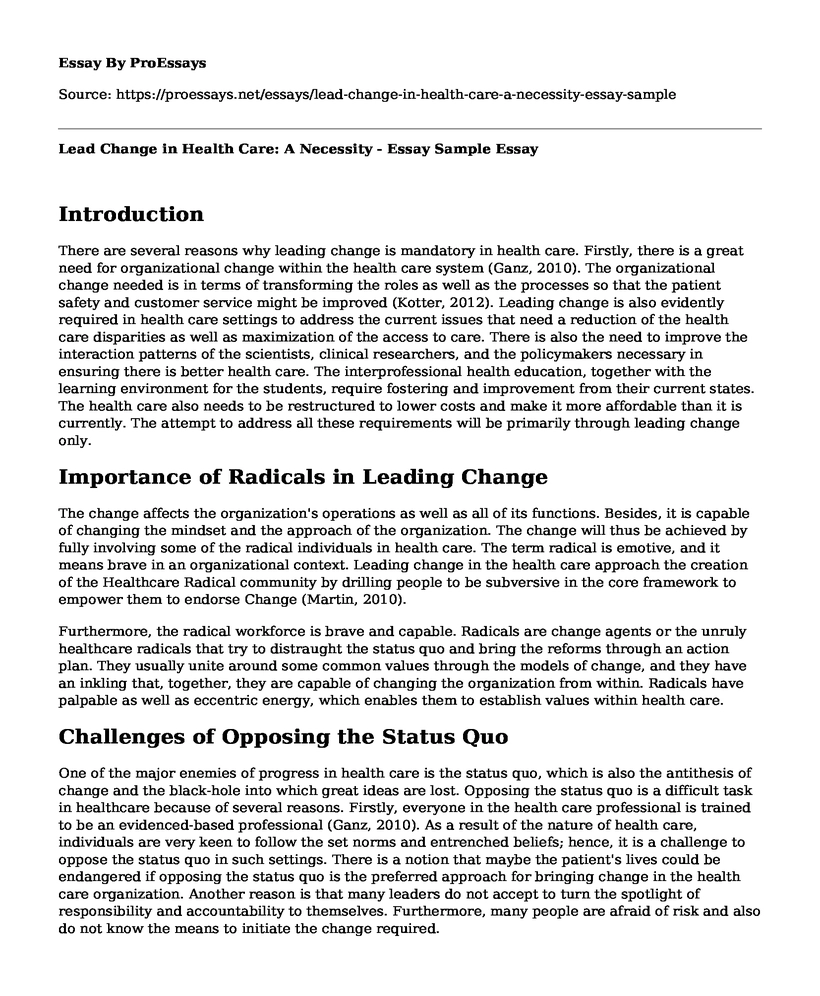Introduction
There are several reasons why leading change is mandatory in health care. Firstly, there is a great need for organizational change within the health care system (Ganz, 2010). The organizational change needed is in terms of transforming the roles as well as the processes so that the patient safety and customer service might be improved (Kotter, 2012). Leading change is also evidently required in health care settings to address the current issues that need a reduction of the health care disparities as well as maximization of the access to care. There is also the need to improve the interaction patterns of the scientists, clinical researchers, and the policymakers necessary in ensuring there is better health care. The interprofessional health education, together with the learning environment for the students, require fostering and improvement from their current states. The health care also needs to be restructured to lower costs and make it more affordable than it is currently. The attempt to address all these requirements will be primarily through leading change only.
Importance of Radicals in Leading Change
The change affects the organization's operations as well as all of its functions. Besides, it is capable of changing the mindset and the approach of the organization. The change will thus be achieved by fully involving some of the radical individuals in health care. The term radical is emotive, and it means brave in an organizational context. Leading change in the health care approach the creation of the Healthcare Radical community by drilling people to be subversive in the core framework to empower them to endorse Change (Martin, 2010).
Furthermore, the radical workforce is brave and capable. Radicals are change agents or the unruly healthcare radicals that try to distraught the status quo and bring the reforms through an action plan. They usually unite around some common values through the models of change, and they have an inkling that, together, they are capable of changing the organization from within. Radicals have palpable as well as eccentric energy, which enables them to establish values within health care.
Challenges of Opposing the Status Quo
One of the major enemies of progress in health care is the status quo, which is also the antithesis of change and the black-hole into which great ideas are lost. Opposing the status quo is a difficult task in healthcare because of several reasons. Firstly, everyone in the health care professional is trained to be an evidenced-based professional (Ganz, 2010). As a result of the nature of health care, individuals are very keen to follow the set norms and entrenched beliefs; hence, it is a challenge to oppose the status quo in such settings. There is a notion that maybe the patient's lives could be endangered if opposing the status quo is the preferred approach for bringing change in the health care organization. Another reason is that many leaders do not accept to turn the spotlight of responsibility and accountability to themselves. Furthermore, many people are afraid of risk and also do not know the means to initiate the change required.
Summary of the Approach
Eight central strategies can summarize the approach for a successful leading change in health care organizations. The first step is developing a vision for change for the organization by first understanding the need to change (Ganz, 2010). The second step is focusing on the leading change process to make it a smooth experience. Thirdly, it will be analyzing the persons in the organization that will be responding to leading change that have been proposed as well as the possible barriers in the process. The fourth phase will be building the necessary partnerships among the physicians and the administration. Fifthly, a culture of continuous obligation to the Leading Change will be established. The sixth step is ensuring that the proposed change is instigated by the leadership. The last steps will be ensuring that change is communicated well to every department in the healthcare organization and should be built-in accountability for change.
References
Ganz, M. (2010). Leading Change: Leadership, organization, and social movements. Handbook of leadership theory and practice, 19.
Kotter, J. P. (2012). Leading Change. Harvard business press. Retrieved from http://itmporgchange.pbworks.com/f/Kotter.pdf
Martin, V. (2010). Leading change in health and social care. Routledge. Retrieved from https://www.sciencedirect.com/science/article/pii/S107032410026032X
Cite this page
Lead Change in Health Care: A Necessity - Essay Sample. (2023, Mar 13). Retrieved from https://proessays.net/essays/lead-change-in-health-care-a-necessity-essay-sample
If you are the original author of this essay and no longer wish to have it published on the ProEssays website, please click below to request its removal:
- High Levels of Curative Health Expenditures
- The Progressive Era: Emerging Concepts of Social Work and Social Welfare From 1900 to 1930
- My Journey to Become a Soft-Hearted Caregiver - Essay Sample
- Culturally Competent Nursing: Respecting Diversity in Care - Essay Sample
- Alzheimer's: Mental Illness Progressively Robbing Memory & Thinking - Essay Sample
- Essay Sample on Quit Smoking Now: Regain Your Health and Avoid Heart Disease Death
- Essay Sample on Prompt Response to OSHA Citations & Penalties







